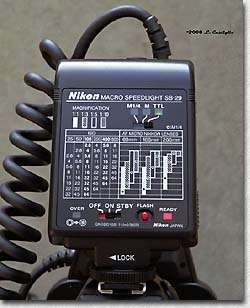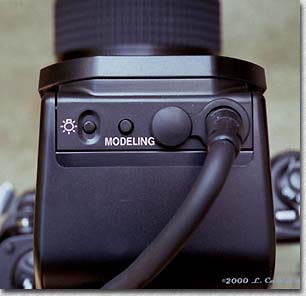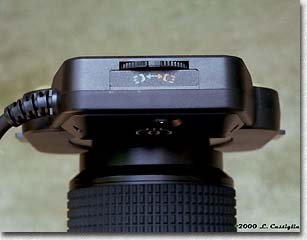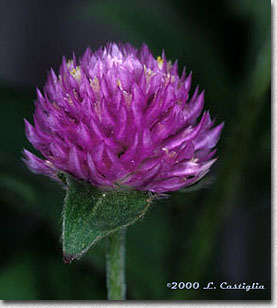
|

Camera Equipment Review...
Nikon SB29 Macro Speedlight
Text Copyright and Photography Copyright Larry Castiglia
All rights reserved.
 In macro photography, as in all photography, nothing is more important to an image than light. As easy as it can be to take flash photos, mastering the control of light in close-up photography can be a real challenge even to the most advanced photographer. Many of today’s camera manufacturers have tried to simplify the flash challenge with units designed specifically for close-up photography. Most of these units are designed to take full advantage of the cameras TTL flash system, which is integrated with the camera’s metering system used for reading ambient light. Nikon, known to have the most advanced flash system on the market today, has come out with an all-new, completely re-designed, TTL Macro Speedlight-- SB-29. This unit has a host of new features that make it a very powerful and versatile compared to its predecessor the SB-21.
In macro photography, as in all photography, nothing is more important to an image than light. As easy as it can be to take flash photos, mastering the control of light in close-up photography can be a real challenge even to the most advanced photographer. Many of today’s camera manufacturers have tried to simplify the flash challenge with units designed specifically for close-up photography. Most of these units are designed to take full advantage of the cameras TTL flash system, which is integrated with the camera’s metering system used for reading ambient light. Nikon, known to have the most advanced flash system on the market today, has come out with an all-new, completely re-designed, TTL Macro Speedlight-- SB-29. This unit has a host of new features that make it a very powerful and versatile compared to its predecessor the SB-21.
Among many new features of this unit, one of the most important is the addition of the “D-Signal” feature: A feature on all Nikon speedlight’s from the SB-25 and newer. The distance signal feature allows all Nikon D lenses to tell the camera the distance that lens is focused, then relay that information to the flash. Next, the matrix meter in the camera analyzes the scene for contrast and brightness and adds the distance into the equation to make for what Nikon calls unparalleled flash photography.
 The SB-29 consists of two components, the main unit and the controller. The main unit is designed around the SB-22s and has a provision to attach the controller to the front of it to take close-up flash photographs; a nifty little feature where the light would be better positioned off the front of the lens. The controller can be rotated 90 degrees when attached to the front of the lens, and can be set horizontally or vertically to match the subject or your individual preferences. The controller has two flash modules and a modeling light for low light focus assist. Both flash modules can be fired at the same time, or they can be fired independently of each other by the simple flick of a switch on the rear panel of the controller. The brightness of the flash module can be reduced to approximately ¼ flash output by using the built-in light reducer (new feature) found on the top of the controller. This feature sets the brightness of the right flash module to the left one (or vice versa) to 1:4: An excellent feature for achieving lighting ratios for studio type lighting effects.
The SB-29 consists of two components, the main unit and the controller. The main unit is designed around the SB-22s and has a provision to attach the controller to the front of it to take close-up flash photographs; a nifty little feature where the light would be better positioned off the front of the lens. The controller can be rotated 90 degrees when attached to the front of the lens, and can be set horizontally or vertically to match the subject or your individual preferences. The controller has two flash modules and a modeling light for low light focus assist. Both flash modules can be fired at the same time, or they can be fired independently of each other by the simple flick of a switch on the rear panel of the controller. The brightness of the flash module can be reduced to approximately ¼ flash output by using the built-in light reducer (new feature) found on the top of the controller. This feature sets the brightness of the right flash module to the left one (or vice versa) to 1:4: An excellent feature for achieving lighting ratios for studio type lighting effects.
Multiple flash operation is possible by using the SC-17, SC-24, or the Wireless Flash Controller SU-4, along with any Nikon speedlight. The combination of the SB-29 and any number of additional speedlights can make creative lighting effects endless. When the light is too dim for normal AF operation, the SB-29’s AF assist illuminator (new feature) can be used to illuminate dark subjects for accurate focusing. To turn on the AF assist illuminator, simply press the button on top of the main unit. The illuminator will remain on until the shutter is released, or it will turn itself off after approximately one minute. To turn it off sooner you can press the button on top of the main unit.
Once you decide on the lighting effect you would like to achieve, pressing the modeling illuminator button (new feature) on the main unit allows you to preview the lighting effect and see how your shadows will look before actually taking the picture. While the modeling illuminator button is pressed, the modeling illuminator lights up for duration of about 3 seconds when both flash modules are fired and the unit is completely recycled.
 The user has several battery options for powering this flash unit. Four AA alkaline batteries will run the unit nicely and will last a considerable amount of time when the flash is set to the standby mode. In the standby mode the SB-29 automatically turns itself off after approximately 80 seconds to conserve battery power. Other optional battery sources compatible with this unit are lithium AA’s, NiCad AA’s, and NiMh AA rechargeable batteries. Alkaline batteries are the least expensive, lithium’s will last the longest and are not affected by cold weather, and NiMH’s are convenient as they have a zero memory effect and can be recharged at any time.
The user has several battery options for powering this flash unit. Four AA alkaline batteries will run the unit nicely and will last a considerable amount of time when the flash is set to the standby mode. In the standby mode the SB-29 automatically turns itself off after approximately 80 seconds to conserve battery power. Other optional battery sources compatible with this unit are lithium AA’s, NiCad AA’s, and NiMh AA rechargeable batteries. Alkaline batteries are the least expensive, lithium’s will last the longest and are not affected by cold weather, and NiMH’s are convenient as they have a zero memory effect and can be recharged at any time.
The SB-29 unit works beautifully, is very well thought-out, and comes with a carrying case that holds the main unit, controller, and the 52mm, 62mm, and 72mm adapter rings (supplied) for attaching the controller to the front all Nikon Micro-Nikkors (note that the 60mm Micro Nikkor requires the optional Nikon UR-3 adapter ring in order to connect the SB-29’s controller to the front it). The unit can also be used with other Nikkor lenses with some limitations.
The SB-29, with a street price of around $400.00, should be very attractive to photographers with a passion for close-up photography.
Specifications

- Electronic construction - Automatic silicon-controlled rectifier and series circuitry.
- Power source - Four AA-type zinc- carbon (1.5V), alkaline-manganese (1.5V), lithium (1.5V), NiCd (rechargeable), (1.2V) or Ni-MH (rechargeable), (1.2V) penlight batteries.
- Guide number (at ISO 100, m) - 11 for both flash modules (12 for single module) at full flash output.
5.5 for both modules (6.0 for single module) at M ¼ flash output.
- Angle of coverage - Covers picture angle of 20mm lens (flash modules set horizontally), and 24mm lens (flash modules set vertically) at a distance of 1m (3.3ft.) with 35mm film cameras.
- Power switch - 1) Three positions are provided: OFF, ON, and STBY (standby)
2) At ON and STBY positions, the SB-29 is turned on.
3) At STBY position, the SB-29 automatically turns itself off after approx. 80 seconds to conserve battery power, if the flash is not used.
- Flash mode selector - TTL, M, or M1/4 mode selectable.
- Ready light - Lights up when SB-29 is recycled and ready to fire.
Blinks for 3 seconds when flash fires at it’s maximum output, indicating light
may be insufficient (in TTL mode).
- Overexposure warning indicator LED - Lights up for approx. 4 sec. After shooting to indicate that the picture may have been overexposed.
- Built-in light reducer - Sets the ratio of the brightness of the right flash module to the left one (or vise versa) to 1:4.
- Flash button - Performs test firing for correct exposure determination.
2) Can turn the SB-29 on again after the unit enters standby mode.
- Flash Duration (approx.) - At full flash output: 1/1400 sec. With both flash modules (1/1250 sec. W/single flash module)
At ¼ flash output: 1/5500 sec. With both flash modules (1/3300 sec. W/single flash module)
- Modeling illuminator - Lights up for approx. 3 sec. (when both flash modules are fired), if flash is completely recycled. Repeat firing at approx. 40Hz.
- Other features - Sync/multiple flash terminal provided.
- Dimensions (W x H x D) - Main unit: Approx. 119 x 113 x 28.5mm (4.7 x 5.2 x 1.1 in.). Controller: Approx. 69 x 106.5 x 88.5mm (2.7 x 4.2 x 3.5 in.)
- Weight - Approx. 410g (14.5 oz.) without batteries
- Accessories supplied - 3 Adapter Rings (52mm, 62mm, 72mm), Hard Case SS-29
LC-NPN
|

 In macro photography, as in all photography, nothing is more important to an image than light. As easy as it can be to take flash photos, mastering the control of light in close-up photography can be a real challenge even to the most advanced photographer. Many of today’s camera manufacturers have tried to simplify the flash challenge with units designed specifically for close-up photography. Most of these units are designed to take full advantage of the cameras TTL flash system, which is integrated with the camera’s metering system used for reading ambient light. Nikon, known to have the most advanced flash system on the market today, has come out with an all-new, completely re-designed, TTL Macro Speedlight-- SB-29. This unit has a host of new features that make it a very powerful and versatile compared to its predecessor the SB-21.
In macro photography, as in all photography, nothing is more important to an image than light. As easy as it can be to take flash photos, mastering the control of light in close-up photography can be a real challenge even to the most advanced photographer. Many of today’s camera manufacturers have tried to simplify the flash challenge with units designed specifically for close-up photography. Most of these units are designed to take full advantage of the cameras TTL flash system, which is integrated with the camera’s metering system used for reading ambient light. Nikon, known to have the most advanced flash system on the market today, has come out with an all-new, completely re-designed, TTL Macro Speedlight-- SB-29. This unit has a host of new features that make it a very powerful and versatile compared to its predecessor the SB-21. The SB-29 consists of two components, the main unit and the controller. The main unit is designed around the SB-22s and has a provision to attach the controller to the front of it to take close-up flash photographs; a nifty little feature where the light would be better positioned off the front of the lens. The controller can be rotated 90 degrees when attached to the front of the lens, and can be set horizontally or vertically to match the subject or your individual preferences. The controller has two flash modules and a modeling light for low light focus assist. Both flash modules can be fired at the same time, or they can be fired independently of each other by the simple flick of a switch on the rear panel of the controller. The brightness of the flash module can be reduced to approximately ¼ flash output by using the built-in light reducer (new feature) found on the top of the controller. This feature sets the brightness of the right flash module to the left one (or vice versa) to 1:4: An excellent feature for achieving lighting ratios for studio type lighting effects.
The SB-29 consists of two components, the main unit and the controller. The main unit is designed around the SB-22s and has a provision to attach the controller to the front of it to take close-up flash photographs; a nifty little feature where the light would be better positioned off the front of the lens. The controller can be rotated 90 degrees when attached to the front of the lens, and can be set horizontally or vertically to match the subject or your individual preferences. The controller has two flash modules and a modeling light for low light focus assist. Both flash modules can be fired at the same time, or they can be fired independently of each other by the simple flick of a switch on the rear panel of the controller. The brightness of the flash module can be reduced to approximately ¼ flash output by using the built-in light reducer (new feature) found on the top of the controller. This feature sets the brightness of the right flash module to the left one (or vice versa) to 1:4: An excellent feature for achieving lighting ratios for studio type lighting effects. The user has several battery options for powering this flash unit. Four AA alkaline batteries will run the unit nicely and will last a considerable amount of time when the flash is set to the standby mode. In the standby mode the SB-29 automatically turns itself off after approximately 80 seconds to conserve battery power. Other optional battery sources compatible with this unit are lithium AA’s, NiCad AA’s, and NiMh AA rechargeable batteries. Alkaline batteries are the least expensive, lithium’s will last the longest and are not affected by cold weather, and NiMH’s are convenient as they have a zero memory effect and can be recharged at any time.
The user has several battery options for powering this flash unit. Four AA alkaline batteries will run the unit nicely and will last a considerable amount of time when the flash is set to the standby mode. In the standby mode the SB-29 automatically turns itself off after approximately 80 seconds to conserve battery power. Other optional battery sources compatible with this unit are lithium AA’s, NiCad AA’s, and NiMh AA rechargeable batteries. Alkaline batteries are the least expensive, lithium’s will last the longest and are not affected by cold weather, and NiMH’s are convenient as they have a zero memory effect and can be recharged at any time.